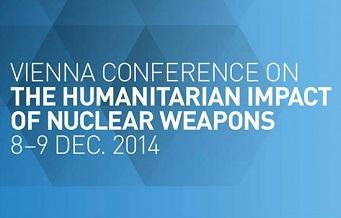"From Vienna to New York: The bumpy road to nuclear disarmament"

Commentary by Amb. (Ret'd) Paul Meyer
Senior Fellow, The Simons Foundation
Published by Canadian International Council's OPENCANADA.ORG, Canada's Hub for International Affairs
January 29, 2015
The practical process to achieve a world without nuclear weapons has been challenging. New options to overcome the impasse are now on the table: a ban, a convention, and a step-by-step approach
Under the gaze of playful cherubs and florid murals, the Festival Hall of the Imperial Hofburg Palace in Vienna seems an incongruous venue for debating the existential threat posed by nuclear weapons.
This was however the locale of the Third Conference on the Humanitarian Impact of Nuclear Weapons (Dec. 8-9, 2014). The event brought together hundreds of delegates representing 158 states and as many international organizations and NGOs. The Vienna Conference followed two earlier international conferences on the same theme held in Oslo, Norway in March 2013 and Nayarit, Mexico in February 2014. All these gatherings constituted a sort of diplomatic riff on a one-sentence theme that was first expressed in the outcome document of the 2010 Nuclear Non-Proliferation Treaty (NPT) Review Conference.
That outcome, agreed to by all 189 states parties to the NPT, expressed the Review Conference’s “…deep concern at the catastrophic humanitarian consequences of any use of nuclear weapons and reaffirms the need for all states at all times to comply with applicable international law, including international humanitarian law.”
To the uninitiated, this would seem a banal assertion of the obvious, but within the dry discourse of NPT meetings it represented a refreshing breeze with its invocation of humanitarian principles and the moral hazards associated with the use or threat of use of nuclear weapons. Many states party to the NPT welcomed this new focus on the humanitarian imperative for nuclear disarmament. This stance was manifested in a major statement delivered by New Zealand on behalf of 155 states to this fall’s session of the First (Disarmament) Committee of the UN General Assembly. The International Red Cross/Red Crescent movement and a vast array of civil society groups have also been vocal supporters of the humanitarian impetus for nuclear disarmament.
Despite their having been party to the 2010 NPT Review Conference outcome affirming the humanitarian theme, the five nuclear weapon states (U.S., UK, France, Russia and China) have been less than enthusiastic about the humanitarian initiative. They had collectively boycotted the previous Oslo and Nayarit conferences and for some months it appeared that they would do the same for Vienna. However, the forthcoming NPT Review Conference (April/May 2015 in New York) and perhaps the recognition that continued stonewalling on engagement with the humanitarian caucus might not endear them with states which with they would need to cooperate to ensure a successful outcome at that Review Conference appeared to have led to a change of position on the part of at least two of the nuclear weapon states.
A few weeks prior to the convening of the Vienna conference the United States announced it would attend the meeting and a short time later the United Kingdom also decided to participate with an official delegation. Continue reading at OPENCANADA.ORG...
Amb. (Ret'd) Paul Meyer is a Fellow in International Security, Centre for Dialogue, Simon Fraser University in Vancouver, Canada, and Senior Fellow, The Simons Foundation.